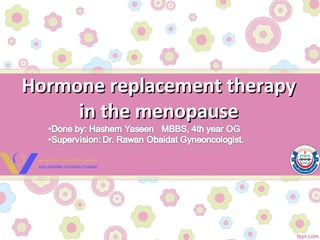Hormone replacement therapy outlines the definitions, physiological changes, symptoms, diagnosis, and treatment options associated with menopause. It discusses indications and contraindications for HRT and provides details on different HRT regimens. Side effects of estrogen and progestogen are listed. Large studies on HRT like the Heart and Estrogen/Progestin Replacement Study and the Women's Health Initiative Study are summarized, noting their findings on risks and benefits of HRT use.




















![Topical HRT: vaginal estrogenTopical HRT: vaginal estrogen
• vulvovaginal atrophy (now referred to as “genitourinaryvulvovaginal atrophy (now referred to as “genitourinary
syndrome of menopause” [GSM])syndrome of menopause” [GSM])
• Cornification and regeneration of the vaginal epithelium.Cornification and regeneration of the vaginal epithelium.
• Improves lubrication and sexual function.Improves lubrication and sexual function.
• Systemic absorption is insignificant.Systemic absorption is insignificant.
• May reduce symptoms of urgency of micturition andMay reduce symptoms of urgency of micturition and
recurrent urinary tract infections.recurrent urinary tract infections.
• Additional systemic progestogen is not requiredAdditional systemic progestogen is not required
• In such cases both topical and systemic may requireIn such cases both topical and systemic may require
• Safety in breast cancer ??,Safety in breast cancer ??, The benefits to the genitourinary tract alongThe benefits to the genitourinary tract along
with improved sexual intimacy may outweigh the risk.with improved sexual intimacy may outweigh the risk.](https://image.slidesharecdn.com/hrthashem2016-160925124310/85/HRT-hashem-2016-pptx-21-320.jpg)
























![DoseDose
• oral 17-beta estradiol [0.5 mg/day]oral 17-beta estradiol [0.5 mg/day]
• 0.025 mg of transdermal estradiol → 0.03750.025 mg of transdermal estradiol → 0.0375
mg → 0.05 mg (reassessment monthly)mg → 0.05 mg (reassessment monthly)
• bilateral oophorectomybilateral oophorectomy: require higher doses up to 0.1 mg: require higher doses up to 0.1 mg
transdermal estradiol for the first two to three years after surgery; thetransdermal estradiol for the first two to three years after surgery; the
dose can subsequently be tapered down.dose can subsequently be tapered down.
• Estrogen should be administered continuouslyEstrogen should be administered continuously
• oral micronized progesterone (200 mg/day for 12oral micronized progesterone (200 mg/day for 12
days of each calendar month).days of each calendar month).](https://image.slidesharecdn.com/hrthashem2016-160925124310/85/HRT-hashem-2016-pptx-46-320.jpg)





